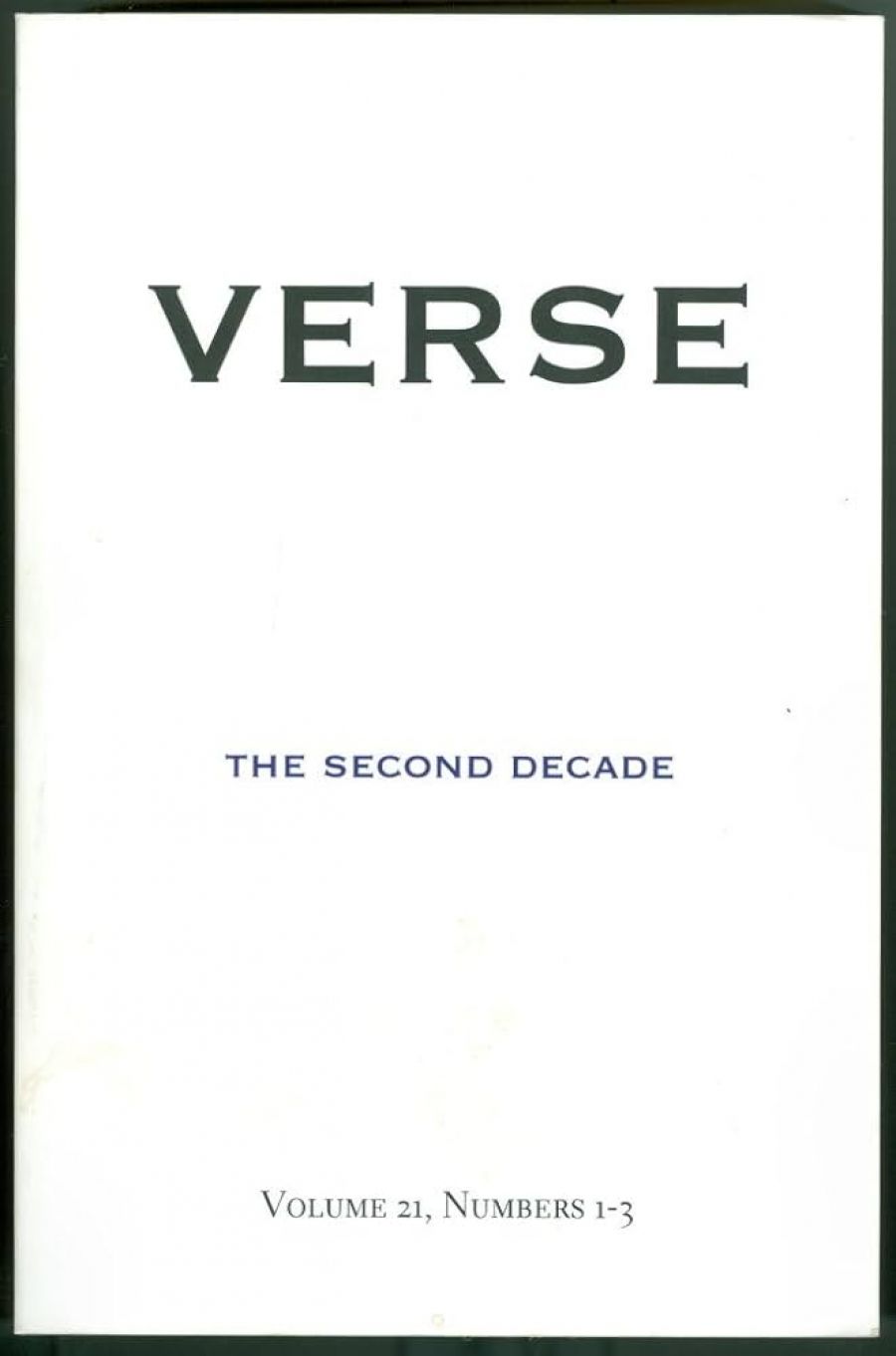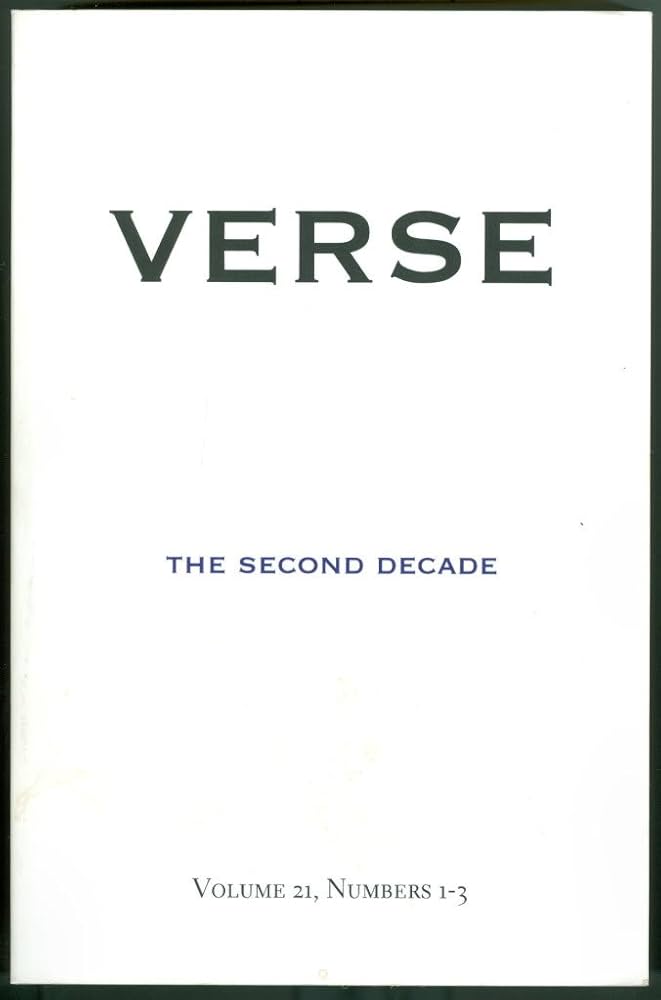
- Free Article: No
- Contents Category: Journal
- Review Article: Yes
- Article Title: Griffonage and stardust
- Online Only: No
- Custom Highlight Text:
In this special anniversary issue of the North American journal Verse, sub-titled The Second Decade, one can find a poem by Ethan Paquin called ‘New Form’. Its first line reads: ‘Ablution when stitched with pertussitine hate.’ Pertussitine? One of the most striking things about this large, impressive collection of contemporary poetry is its penchant, indeed rage, for the obscure word. After a while, I just left the Shorter Oxford next to me when I was reading, but it didn’t always help when I came across words like ‘usufruct’, ‘blisson’, ‘eldritch’, ‘rutabagas’ (North American for ‘swedes’), ‘alginate’, ‘geode’, ‘arroyos’, ‘aretes’ (those last four from one poem), ‘catafalque’, ‘cartouche’, ‘penetralia’, ‘solatium’, ‘griffonage’, ‘exogamous’, ‘matutinal’ and (twice) ‘pled’ (the past participle of ‘plead’). It’s a mildly interesting parlour game to see which words my computer recognises.
- Book 1 Title: Verse
- Book 1 Subtitle: The second decade vol. 21, nos. 1-3
- Book 1 Biblio: Verse, 624 pp
- Book 1 Cover Small (400 x 600):

- Book 1 Cover (800 x 1200):

Verse is drunk with words, in love with the arcane. Looking over my own griffonage (scribble or scrawl), in the form of my notes for this review, I see a number of salient features regarding this attraction to arcane words. There is the attention to the materiality of language, to language as a ‘fallen’ medium, to poetry, one might say, ‘after theory’. There is also an attraction to language as a game, to riddle poems and to cerebral poetry. This latter feature is seen in the many slyly essayistic titles of poems: ‘The Birth of Tragedy’, ‘The Roots of Romanticism’, ‘Nine Ways of Writing an American Poem’, ‘The Aesthetics of Dusk’, ‘The Surrealist Revolution’, ‘The Fabric of Will in the Material Landscape’, and so on. This is poetry that, even when being playful, is pretty serious stuff. (J.S. Harry’s ‘A Rabbit’s Introduction to Australian History’, otherwise relevant here, is too searing a critique of Australian attitudes to be described merely as playful.)
Such features are consistent with the journal’s seriousness. Interestingly, there has been less need, apparently, in the US for highbrow journals to adopt full-colour covers, themed issues and forays into popular culture. The austerity of this journal is a welcome astringent, and this special issue, celebrating the journal’s second decade, is impressively low-key in presentation. There is a one-page ‘editor’s note’ (from Brian Henry), and indices of interviews and books reviewed in the last ten years. Otherwise, the poetry (organised alphabetically by author) is left to speak for itself. The size of this triple issue is probably the most ostentatious thing about it. As well as reprinting highlights from the last ten years, there is also a large slab of new work.
However ‘North American’ Verse may seem in its unadorned commitment, it is impressively internationalist in spirit. In this anniversary issue, there are 250 poets represented from more than two dozen countries. Of these, about 100 are not from the US. As this issue illustrates, Verse has had an impressive roster of contributors: notables include John Ashbery, Paul Muldoon, Kenneth Koch, Charles Simic, Peter Redgrove and Peter Porter (who has, for me, two of the collection’s best poems).
Porter’s name is one of the more obvious examples of an ‘Australian connection’ concerning Verse. This connection is in part biographical and scholarly. Both Henry and Andrew Zawacki have visited Australia and studied its poetry. They have also both written on Australian poetry. (Henry, as seen in his recent ABR review of Les Murray’s The Best Australian Poems 2004, is a forthright critic.) The ‘Australian connection’ in this collection is quite marked. For those interested in what Verse might offer an Australian reader (other than 600 pages of mostly impressive or startling poetry), they will find a stylish and authoritative international context in which to read ‘Australian’ poetry. Australia is well represented, with work from some of our best poets (both younger and older).
What is interesting in this context, however, is how little poets’ nationalities matter. They are not listed by the editors. What Australian readers see, then, is the worldliness of Australian poetry. There are very few indications of anything as parochial as a ‘national style’ (though the various poems translated from European languages do tend to the dazzlingly surreal). What is interesting are the similarities between Australian and non-Australian poets.
No doubt the editors’ tastes are at work. (And some readers might, like me, find the high-concept nature of most of this poetry a little wearying after a while.) But there is more than just editorial taste operating here. In part, this collection tells us something about the condition of contemporary poetry itself. Laurie Duggan in his latest book, Mangroves (2003), has this to say about contemporary poetry: ‘Most poetry exists as a kind of memorial for its lost self; it inhabits the realm of the cultural artifact “poem” like a tramp in a condemned apartment building.’ Poetry exists, Duggan points out, in a post-poetic age. This is especially resonant for poets as sophisticated as those published by Verse. Its resonance can be seen in the tension in this collection between lyrical and anti-lyrical impulses (often within the one poem). Peter Johnson’s prose poem ‘The Hero’, for instance, begins: ‘End of the twentieth century and I’m still angry. The new hero same as the old hero. And the poets? They’re in the backyard playing in the wet mulch, writing each other love letters with bird shit on brown paper bags.’ Or else there is the figure in John Tranter’s ‘The Twilight Guest’ who ‘purchased / a little cottage by the lake – / fresh-water, not salt – / and sat waiting for poetry’.
At its worst, the poetry in Verse can seem indistinguishable and arid. Sometimes whole poems are like glosses on obscure words or even a collection of obscure words. Sometimes the wrenching of syntax can be plain annoying, but for the most part this collection is compelling. Sometimes, as in the case of the extracts from Joe Wenderoth’s ‘Letters to Wendy’s’ (Wendy’s being a fast-food chain), it is compellingly weird and unsettling, even terrible: ‘The road to heaven is paved with meat: the road to meat is not paved at all.’ More quietly unsettling are the poems by James Tate (especially ‘Intruders’) and Charles Simic.
Much of the Australian poets’ work looks uncannily at home. Emma Lew’s extraordinary poems no longer seem ‘un-Australian’ in their tropes or content (with their references to crinoline, wolves, flax, lairs of spies, and so on). John Kinsella’s utterly original interventions in landscape poetry show the strange connections between antipodean and Northern places and ways of thinking. Similarly, Tracy Ryan’s marvellous, essayistic ‘Mallee Root’ presents the peculiarly local in a richly cosmopolitan way.
One of the best poems in the collection is by the Melbourne poet Peter Steele. His ‘Stardust’ is both engagingly lyrical and brilliantly erudite. Like the old jazz tune that shares its title (at least as played by Louis Armstrong), it is simultaneously sparkling and heartbreaking. It is also, appropriately for this collection of poems, global in its scope, taking in ‘our curious planet’ from the Grand Canyon to the Sargasso, from the ‘rowed incessancy of cornfields’ to the ‘quilt of cities’. Verse: The Second Decade, as a whole, gives witness to such variety and strangeness. It is hardly any surprise, then, that I discover from it the meanings, perhaps even the poetry, of ‘alginate’, ‘cartouche’ and ‘solatium’.


Comments powered by CComment